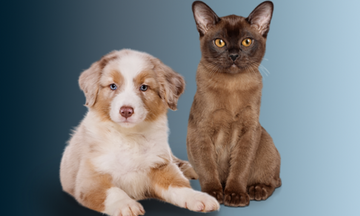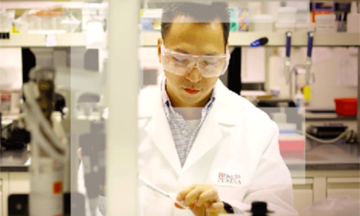微生物叢の基礎知識

今までは、腸内微生物叢に大きな注目が寄せられてきましたが、体の表面や体内には多数の微生物叢が存在します。1
微生物叢は、口腔、結膜、外耳、皮膚、上気道、下気道、生殖器、尿路など、微生物が生息する体内のあらゆる場所に存在します。身体の部位は、pH、表面の形状、水分量などの物理的・化学的特性により、細菌の構成が大きく異なります。2
ヒトの微生物叢に関する研究は、腸以外の微生物叢に関する調査が加速しているため、急速に拡大しています。
犬猫の腸以外の微生物叢の研究は、ヒトの微生物叢研究よりも遅れているため、犬猫の健康の向上する機会はまだ残されていることになります。


口腔内微生物叢
犬猫の口腔内微生物叢は、腸と物理的・機能的なつながりがあるとはいえ、約 200 種、5,000 万~1 億個の細菌で構成される一意の微生物叢です。2-4複数の研究により、犬猫の口腔内微生物叢は同じ優占門に含まれるものの、種によって存在量が異なっていることが示されています。3,5,6,7さらに、口腔内の場所により微生物集団が異なることも明らかになっています。8
犬の口腔内微生物叢は、犬全体で高度に保存されており、品種間で顕著な相違はないと見られています。3これに対して、猫のいくつかの品種間、屋外猫と室内飼い猫との間では、口腔内微生物叢の多様性と相対存在量に顕著な差が観察されています。9
口腔内微生物叢の変化は、出産方法(帝王切開または経腟)5、猫では食餌の形態(ウェットかドライか、母乳から市販のフードに変更したか)5,10、犬への歯垢軽減効果のあるデンタルガムの給与 11、経口プロバイオティクスの給与 12、歯科予防処置 13、口腔内疾患(歯周炎、歯肉炎、歯肉口内炎など)14-18 に関連性があることが報告されています。しかし、微生物叢の変化が疾患に先行して生じ、疾患の素因となっているのか、または変化した環境に反応して細菌集団が移動したことを反映しているのかについては、さらなる研究が必要です。3,19,20
口腔内微生物叢は変化するものの、強靭であることが報告されています。3,13
皮膚微生物叢
犬猫の皮膚微生物叢は、ほとんどが類似の細菌門で占められていますが、ヒトの皮膚微生物叢に比べ、多様性に富んでいます。21口腔内微生物叢でも観察されたように、犬と猫の皮膚微生物叢には同じ優占門がありますが、その存在比が異なります。21犬も猫も、有毛部位には、粘膜接合部や粘膜皮膚移行部に比べてより多くの細菌が見られました。21皮膚微生物叢が健康や疾患にどのように関与しているかの全体像はほとんど判明していませんが 22、皮膚の第一のバリアとしての役割と免疫系との密接なつながりから、皮膚微生物叢が宿主の健康において重要な役割を果たしていることが示唆されています。
犬と猫の皮膚微生物叢に関する研究の大半は、健康な犬猫とアレルギー/アトピーのある犬猫との比較に焦点を当てています。
当然のことながら、研究では、健康な猫とアレルギーのある猫、健康な犬とアレルギー/アトピーのある犬の皮膚微生物叢には顕著な違いがあり、アレルギー/アトピーに伴って多様性や豊富さが低下していることが報告されました。21,23-26
微生物叢フォーラムの他の領域を見る
詳しく知る
- Yang, J. (2012, July 16). The Human Microbiome Project: Extending the definition of what constitutes a human. National Humane Genome Research Institute Genome Advance of the Month. https://www.genome.gov/27549400/the-human-microbiome-project-extending-the-definition-of-what-constitutes-a-human
- Koidl, L., & Untersmayr, E. (2021).The clinical implications of the microbiome in the development of allergy diseases.Expert Review of Clinical Immunology, 17, 115—126. doi:10.1080/1744666X.2021.1874353
- Bell, S. E., Nash, A. K., Zanghi, B. M., Otto, C. M., & Perry, E. B. (2020). Assessment of the stability of the canine oral microbiota a er probiotic administration in healthy dogs over time. Frontiers in Veterinary Science, 7, 616. doi:10.3389/fvets.2020.00616
- Dewhirst, F. E., Klein, E. A., Bennett, M.-L., Cro , J. M., Harris, S. J., & Marshall-Jones, Z. V. (2015). The feline oral microbiome: A provisional 16S rRNA gene based taxonomy with full-length reference sequences. Veterinary Microbiology, 175, 294—303. doi:10.1016/j.vetmic.2014.11.019
- Spears, J. K. (2017, May 4-6) Development of the oral microbiome in kittens. Proceedings of the Companion Animal Nutrition Summit, Vancouver, B. C., Canada, 73–81.
- Dewhirst, F. E., Klein, E. A., Thompson, E. C., Blanton, J. M., Chen, T., Milella, L.,…Marshall-Jones, Z. V. (2012). The canine oral microbiome. PLoS ONE, 7(4), e36067. doi:10.1371/journal.pone.0036067
- Sturgeon, A., Pinder, S. L., Costa, M. C., Weese, J. S. (2014). Characterization of the oral microbiota of healthy cats using next-generation sequencing. The Veterinary Journal, 201, 223–229. doi:10.1016/j.tvjl.2014.01.024
- Ruparelli, A., Inui, T., Staunton, R., Wallis, C., Deusch, O., & Holcombe, L. J. (2020). The canine oral microbiome: variation in bacterial population across different niches. BMC Microbiology, 20, 42. doi:10.1186/s12866-020-1704-3
- Older, C. E., Diesel, A. B., Lawhon, S. D., Queiroz, C. R. R., Henker, L. C., & Hoffmann, A. R. (2019). The feline cutaneous and oral microbiota are influenced by breed and environment. PLoS ONE, 14(7), e0220463. doi:10.1371/journal.pone.0220463
- Adler, C. J., Malik, Browne, G. V., & Norris, J. M. (2016). Diet may influence the oral microbiome composition in cats. Microbiome, 4, 23. doi:10.1186/s40168-016-0169-y
- Oba, P. M., Carroll, M., Alexander, C., Lye, L., Somrak, A., Keating, S.,…Swanson, K. S. (2020). Oral microbiota populations of adult dogs consuming dental chews demonstrated to reduce dental plaque and calculus. Journal of Animal Science, 98(Suppl 4), 61.
- Mäkinen, V.-M., Mäyrä, A., & Munukka, E. (2019). Improving the health of teeth in cats and dogs with live probiotic bacteria. Journal of Cosmetics, Dermatological Sciences and Applications, 9, 275–283. doi:10.4236/jcdsa.2019.94024
- Flancman, R., Singh, A., & Weese, J. S. (2018). Evaluation of the impact of dental prophylaxis on the oral microbiota of dogs. PLoS ONE, 13(6), e0199676. doi:10.1371/journal.pone.0199676
- Dolieslager, S. M. J., Bennett, D., Johnston, N., & Riggio, M. P. (2013). Novel bacterial phylotypes associated with the healthy feline oral cavity and feline chronic gingivostomatitis. Research in Veterinary Science, 94, 428–432. doi:10.1016/j.rvsc.2012.11.003
- Davis, E. M. (2016). Gene sequence analysis of the healthy oral microbiome in humans and companion animals. Journal of Veterinary Dentistry, 33(2), 97–107. doi: 10.1177/0909765416657239
- Nakanishi, H., Furuya, M., Soma, T., Hayashiuchi, Y., Yoshicuhi, R., Matsubayashi, M.,…Sasai, K. (2019). Prevalence of microorganisms associated with feline gingivostomatitis. Journal of Feline Medicine and Surgery, 21(2), 103–108. doi:10.1177/1098612X18761274
- Harris, S., Cro , J., O’Flynn, C., Deusch, O., Colyer, A., Allsopp, J.,…Davis, I. J. (2015). A pyrosequencing investigation of differences in the feline subgingival microbiota in health, gingivitis and mild periodontitis. PLoS ONE, 10(11), e0136986. doi:10.1371/journal.pone.0136986
- Older, C. E., de Oliveira Sampaio Gomes, M., Hoffmann, A. R., Policano, M. D., Cruz dos Reis, C. A., Carregaro, A. B.,…Carregaro, V. M. L. (2020). Influence of the FIV status and chronic gingivitis on feline oral microbiota. Pathogens, 9, 383. doi:10.3390/pathogens9050383
- Davis, I. J., Wallis, C., Deusch, O., Colyer, A., Milella, L., Loman, N., Harris, S. (2013). A cross-sectional survey of bacterial species in plaque from client owned dogs with healthy gingiva, gingivitis or mild periodontitis. PLoS ONE, 8(12), e83158. doi:10.1371/journal.pone.0083158
- Holcombe, L. J., Patel, N., Colyer, A., Deusch, O., O’Flynn, C., & Harris, S. (2014). Early canine plaque biofilms: Characterization of key bacterial interactions involved in initial colonization of enamel. PLoS ONE, 9(12), e113744. doi:10.1371/journal.pone.0113744
- Older, C. E., Diesel, A., Patterson, A. P., Meason-Smith, C., Johnson, T. J., Mansell, J.,…Rodrigues Hoffmann, A. (2017). The feline skin microbiota: The bacteria inhabiting the skin of healthy and allergic cats. PLoS ONE, 12(6), e0178555. doi:10.1371/journal.pone.0178555
- Weese, J. S. (2013). The canine and feline skin microbiome in health and disease. Veterinary Dermatology, 24, 173–e31. doi:10.1111/j.1365-3164.2012.01076.x
- Fazakerley, J., Nuttall, T., Sales, D., Schmidt, V., Carter, S. D., Hart, C. A., & McEwan, N. A. (2009). Staphylococcal colonization of mucosal and lesional skin sites in atopic and healthy dogs. Veterinary Dermatology, 20(3), 179–184. doi:10.1111/j.1365-3164.2009.00745.x
- Furiani, N., Scarampella, F., Martino, P. A., Panzini, I., Fabbri, E., & Ordeix, L. (2011). Evaluation of the bacterial microflora of the conjunctival sac of healthy dogs and dogs with atopic dermatitis. Veterinary Dermatology, 22(6), 490–496. doi:10.1111/j.1365-1365-3164.2011.00979.x
- Rodrigues Hoffmann, A., Patterson, A. P., Diesel, A., Lawhon, S. D., Ly, H. J., Elkins Stephenson, C.,…Suchodolski, J. S. (2014). The skin microbiome in healthy and allergic dogs. PLoS One, 9(1), e83197. doi:10.1371/journal.pone.0083197
- Bradley, C. W., Morris, D. O., Rankin, S. C., Chain, C. L., Misic, A. M., Houser, T.,…Grice, E. A. (2016). Longitudinal evaluation of the skin microbiome and association with microenvironment and treatment in canine atopic dermatitis. Journal of Investigative Dermatology, 13(6), 1182–1190. doi:10.1016/j.jid.2016.01.023


